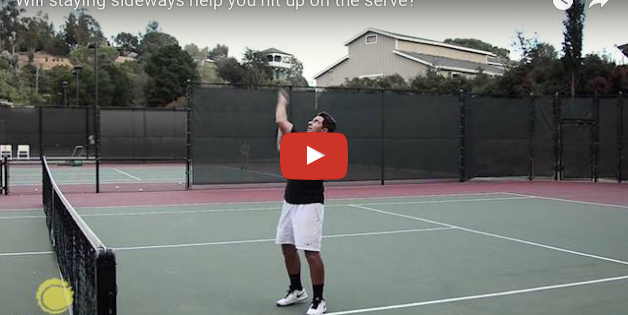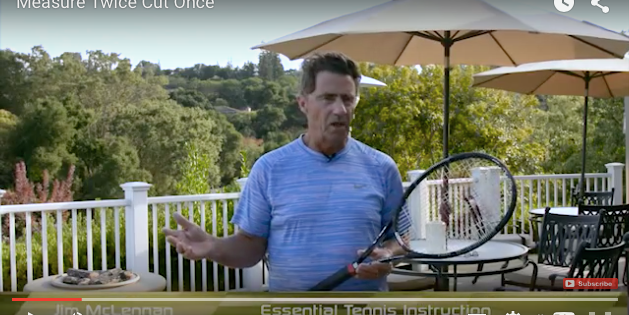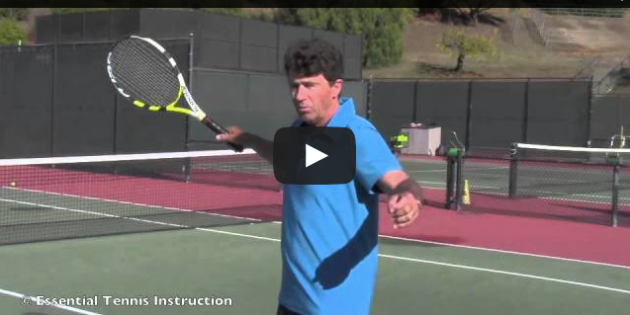Early to Step
Download this Video The most difficult opponent we face is often the “dreaded pusher” – but in spite of this players consistency, this players movement, and often how “poor we think they look” – often the simplest issue here is that their soft floating moon balls deprive you and I of the rhythm we get…
Tennis on the Theory of Golf – Explore with an Open Mind
Your back knee – as in, “the knee bones connected to the hip bone” In golf, as you finish your swing, you are able to easily walk down the fairway Similarly, Tom Stow (who taught the game based on the form of a 3/4 nine iron) trained that on the follow thru if you so…
The Dog Wagging Its Tail
In this photo Djokovic demonstrates perfect posture, and how his body (dog) has truly pulled the arm and racquet (tail.) So how to synchronize the arm and body? Getting the racquet back is not the issue, but rather the rhythm of the racket back and the rotation of the body. Do you take the racquet…
One Handed Topspin Backhand
Dominic Thiem plays Stefanos Tsitsipas in the ATP World Finals on Sunday We will enjoy a demonstration of full throated one handed topspin backhands Heavy crosscourt exchanges And the match may revolve around the boldness and precision when either threads the needle up the line Both have deadly forehands – but the backhand exchanges will…
First Things First – Preparation
What is your first move when you read the incoming ball? Move your feet? Racquet back? How soon? When in relation to the bounce of the incoming ball? For Tom Stow, the first move may have been the most important aspect of the shot. He said, “If it starts correctly, and finished correctly, probably it…
Elbows on Court
Perhaps the most important element in the game is to PREPARE But for sure there can be many ways to turn and get ready My childhood coach, Blackie Jones (pictured at the left) at Acalanes High School in Lafayette California taught me to line up for the ball by pointing the bones in my…
Tennis Jujutsu – it not always “GO BIG OR GO HOME”
The martial art form “Jujutsu” involves manipulating the opponent’s force against themselves. Phrases that arise include flexible, pliable or yielding. I see so much of this in Federer’s game. Especially his low, short skidding slice. Yet somehow I find a lot of the material on the internet is about bigger shots, more power, more spin, with very…
The Underspin Backhand – Rosewall to Federer
The one handed under spin backhand can be a weapon Ken Rosewall drove his nearly flat under spin backhand with ruthless precision to the corners of the court. “Muscles” as he was called. Steffi Graf knifed her under spin backhand, keeping the ball low to ultimately open up the court for her dominating forehand. And…
Steps to a Half Volley like Federer
Photos courtesy Jim Fawcette ©jfawcette Federer astounds on the half volley He makes the most difficult of shots appear simple And this has nothing to do with so-called NO MAN’S LAND, for certainly the ball can land at your feet no matter where you are positioned. Want some simple keys to improving your half volley?…
The Live Arm
Overhand throwing might be a lost art Whether male or female, adult or junior – some throw much better than others. How come? Permit me a guess… Some whip the ball, and others use a subtle pushing motion And for better or worse those two types have similar serving actions Mike Krukow, former Major League…
Wall to the Ball
Both Roger Federer and Bianca Andreescu square the face to the incoming ball – though still moving forward they have both “aligned the wall to the ball.” Tom Stow often introduced the simplicity of the volley technique by using a stool or chair such that the…
ETI 047 | Will Staying Sideways help you hit up on the serve!

The common problem I see at the club, as well as on television, is where the server flexes at the waist at the hit – more or less jackknifing to create a little more ball speed.
And this action creates both forward and downward forces – and is generally associated with netted serves.
ETI 043 | Point of Contact Area of Contact
Ball control – ours is a game of accuracy, of consistency, but equally it is a game of timing for the opponent will send us shots of varying spin, speed, length and difficulty. Timing describes the relation between the incoming ball and the swinging racquet – and certainly the entire game revolves around the moment…
ETI 042 | Measure Twice Cut Once

https://dg2e30wx7kvei.cloudfront.net/eti_podcast/ETI_042_Measure_Twice_Cut_Once.mp4 The carpenter measures twice to cut once, to make sure the cut is accurate, for if too much is cut off that mistake cannot be undone. In tennis consider measuring as preparing first to the side for the incoming ball, but then to measure precisely the height of the backswing such that the racquet…
ETI 041 | Quantum Tennis/Golf
Many interesting parallels have been drawn between the tennis serve and the golf swing. Once the tennis player (or golfer) gets the feel for the mechanical elements of the serve (or golf swing) then rhythm becomes the overriding issue. Does the swing build smoothly and gracefully? Is there economy of effort? Can the server (golfer) swing easily yet hit hard? Are the body parts coordinated so that the force from the legs moves to the hips, and then to the torso, and then to the shoulder, then the arm, then the forearm, then the hand, and finally the fingers?
ETI 038 | Dead Hands
The 3 R’s of tennis – ready, read (where the ball is going) react!
As to your reaction – what precisely is your first move? What moves first, what initiates your preparation?
Really an important question.
ETI 035 | The Dead Spot on the Racquet Face
Swing path, type of spin, power, 3d playback (with Zepp) but perhaps the most interesting as well as the most useful is the data that shows where you make contact on the racquet face.
And before going further, one of the most important (IF NOT THE MOST IMPORTANT) skills in the game of tennis is concentration, focus, and closely and continually watching the ball.
ETI 033 | Throwing vs. the Pendulum
Consider the elements in a strong and fluid overhand throw – and how the actions of the hand and elbow can be used or even copied in the modern forehand as well as certainly the serve.
Once when racquets were heavy and wooden, we could see (and still see now and then) a type of pendulum swing – back and forth with little whip or acceleration. Interestingly McEnroe still uses such a forehand to truly devastating effect.
ETI 030 | Forward Spin
Squaring up – Hitting the ball true – precise contact on the back of the ball.
We all know about topspin – but have you ever tried to strike the ball with true topspin – where the ball rolls forward – precisely forward?
The following drop hit drill will improve your time spent practicing on court – and help you with your forehand and or your backhand.
ETI 025 | Drop Shot – playing North to South
Play the ball to the open court. Run your opponent. Hit it where they “ain’t” (sorry).
Too often we focus on moving the ball east and west, meaning from side to side. Another option, in some instances a better option, is to play the ball deep and short, very deep and very short. Think of this as moving the ball north and south.
Drop shots will do the trick. Backspin, finesse, stroking from high to low with an open racquet face. But, and this is most important, always meet this ball on the rise, from inside the baseline.
ETI 023 | Borrowing Pace – Tennis Ju-jitsu
Tennis ju-jitsu. Blocking, borrowing, deflecting the ball, playing with angles and change of pace.
The game is not always about power and winners. Just as easily the game can become one of rebounding the ball, using the opponent’s force and incoming shot to create our own.
This style, ju-jitsu if you will, comes from shorter strokes, firmer grips at contact, and a willingness to look for angles, dinks, drops and more.
McEnroe was the unquestioned master of this – try it out for yourself.
ETI 021 | Deep and Up the Middle
Time and Angle. Tactics – plain and simple.
If you move the opponent well behind the baseline – you will have more time to respond, and their angle of play becomes smaller.
If that opponent is as deep but in one corner or the other, their angle remains the same but their cross court shot will cross the sideline at a steeper angle.
The famous Jack Kramer was known to play the ball deep and up the middle, whenever he had not gained control of the point with his serve or volley.
The same will work for you.
Drop Hit One Handed Backhands – a hidden practice gem!!

Start a rally; deliver a ball to the adjacent court when responding to “ball please.” In nearly every instance the swing is a drop hit forehand. Sometimes those forehands are deliberate and practiced (that is good). Other times those forehands are wristy, in poor form, somehow not acknowledged as genuine practice opportunities. Truly – practice…
ETI 018 | The Heavy Ball
One of the most common phrases in tennis today is ‘hit a heavy ball’. So what is a heavy ball?
The incoming shot “feels heavy” when that shot has a lot of momentum.
Generally heavy shots are produced with a combination of racquet speed as well as body weight “against the ball.”
ETI 014 | Alignment – Swinging Up and or Down
Many ways to play this game, many ways to grip the racquet, and truly many ways to hit the ball.
Flat, topspin, slice, sidespin, under spin – just to name a few (if not them all).
We know to hit up on the ball for topspin, to swing slightly down on the ball for slice or under spin, and to swing more or less level for a flat hit. And one proviso, the ball will always leave the racquet with some amount of spin, it is impossible to hit the ball perfectly flat. But for our purposes, flat will mean a ball with relatively little spin.

Recent Comments